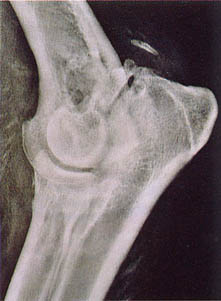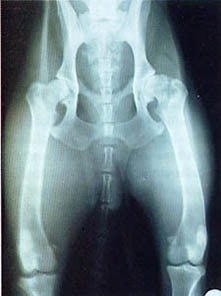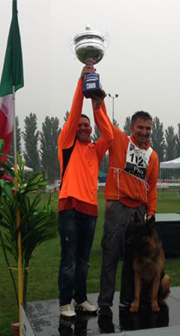HIP DYSPLASIA



The German Shepherd is a utility dog, in other words, indicated for use in diverse activities, which take advantage of its characteristics as well as character and morphological qualities.
It must be an animal capable of running, without any problems, 20 or 30 km a day (if trained).
After a careful observation of the dog’s behaviour and how it reacts to external stimuli, from the character point of view, a complete and true profile can be made regarding its character. From an anatomical-morphological point of view it isn’t as easy and in order to have a complete profile it is not enough to observe the dog externally since some pathologies very often exist that can be noted only through a complete examination by a veterinarian.
The veterinarian who first observes the dog externally must successively subject the dog to some x-rays in order to be sure that the elbows and hips are well-formed and well-positioned in their places.
The pathology of the hip or elbow dysplasia is a genetically transmitted pathology and usually indicates (save in rare cases) that a level of breeding has not been done well or that something has not worked because in order to allow a subject to reproduce, a dog must present a certificate regarding the absence of hip dysplasia. Such malformation can have different levels but in no way can it make a dog admissible for reproduction. In order for a dog to have good possibilities of being free from such a pathology, it must have at least both parents having the certificate of exemption from dysplasia but this should extend to all the forefathers in order to increase the probabilities of not being at risk. These so-called pathologies make the dog unfit for all types of work since dysplasia is a degenerative pathology and, as the years pass, if it is not obvious during puppy hood, will give serious joint problems, during adulthood or old age. The German Shepherd is not the only breed that has these problems. As joints are concerned, it affects all medium-sized breeds. Joint problems can also have other causes, for example: trauma (as a result of fractures), excessive training, environmental causes such as hyper dynamism and overweight (damaging above all during puppy hood since it burdens the joints that are still unprepared to sustain such excess weight), or senile degeneration. In any case, it has been observed that a healthy dog is a healthy dog and will remain so, the dogs that degenerate with one of the aforementioned causes are always, and in every way, dogs that already latently suffer from the pathology. Dogs with such joint pathologies (hip or elbow dysplasia) can often be socially dangerous during the latent stages of the sickness, since suffering a lot of pain, they are not given to activity which includes both work and play, and can transform the pain they feel into aggressive behavior as if asking to be left in peace.
We repeat: such pathologies ARE NOT OBVIOUS by the naked eye save for very serious cases. It is only through the x-ray performed by the veterinarian that its presence can be ascertained. There are no actual remedies for dysplasia. It has to be eradicated from the root by way of conscientious reproduction with the aim of not allowing subjects with such malformations, or even carriers of such pathologies, to reproduce. There are some pharmaceutical drugs on the market that can combat the pain, such as, analgesics, anti-inflammatory medicines and cortisones that combat only the symptoms of the illness without improving the cause that determine them.
It has been observed that administering anti-inflammatory drugs, etc. in continuation and for long periods of time, overburdens the liver (the organ that breaks down toxic substances) and in getting weaker may catch sickness more easily. Surgical intervention is also possible but not humanely adviced since it forces the animal to suffer more against nature by sodomising it unjustly. After a surgical intervention, all the activities of the animal is so compromised that even a banal leap from a low wall (very normal activity for a dog) can be fatal. As a breeder, I’d like to warn all unlucky owners of a dog that has hip dysplasia to stay clear of promises of cures using miraculous products at, without doubt, exorbitant costs. The real war with dysplasia is waged by not buying dogs with parents who do not have the certificate of exemption from dysplasia which is not in simple private writing but a real certificate with an indelible stamp on the pedigree countersigned by the veterinarian who performed the reading of the x-ray. For a serious deepening and updating on this important argument, we advise you to go on the Clemasche website. www.celemasche.it
The pathology of the hip or elbow dysplasia is a genetically transmitted pathology and usually indicates (save in rare cases) that a level of breeding has not been done well or that something has not worked because in order to allow a subject to reproduce, a dog must present a certificate regarding the absence of hip dysplasia. Such malformation can have different levels but in no way can it make a dog admissible for reproduction. In order for a dog to have good possibilities of being free from such a pathology, it must have at least both parents having the certificate of exemption from dysplasia but this should extend to all the forefathers in order to increase the probabilities of not being at risk. These so-called pathologies make the dog unfit for all types of work since dysplasia is a degenerative pathology and, as the years pass, if it is not obvious during puppy hood, will give serious joint problems, during adulthood or old age. The German Shepherd is not the only breed that has these problems. As joints are concerned, it affects all medium-sized breeds. Joint problems can also have other causes, for example: trauma (as a result of fractures), excessive training, environmental causes such as hyper dynamism and overweight (damaging above all during puppy hood since it burdens the joints that are still unprepared to sustain such excess weight), or senile degeneration. In any case, it has been observed that a healthy dog is a healthy dog and will remain so, the dogs that degenerate with one of the aforementioned causes are always, and in every way, dogs that already latently suffer from the pathology. Dogs with such joint pathologies (hip or elbow dysplasia) can often be socially dangerous during the latent stages of the sickness, since suffering a lot of pain, they are not given to activity which includes both work and play, and can transform the pain they feel into aggressive behavior as if asking to be left in peace.
We repeat: such pathologies ARE NOT OBVIOUS by the naked eye save for very serious cases. It is only through the x-ray performed by the veterinarian that its presence can be ascertained. There are no actual remedies for dysplasia. It has to be eradicated from the root by way of conscientious reproduction with the aim of not allowing subjects with such malformations, or even carriers of such pathologies, to reproduce. There are some pharmaceutical drugs on the market that can combat the pain, such as, analgesics, anti-inflammatory medicines and cortisones that combat only the symptoms of the illness without improving the cause that determine them.
It has been observed that administering anti-inflammatory drugs, etc. in continuation and for long periods of time, overburdens the liver (the organ that breaks down toxic substances) and in getting weaker may catch sickness more easily. Surgical intervention is also possible but not humanely adviced since it forces the animal to suffer more against nature by sodomising it unjustly. After a surgical intervention, all the activities of the animal is so compromised that even a banal leap from a low wall (very normal activity for a dog) can be fatal. As a breeder, I’d like to warn all unlucky owners of a dog that has hip dysplasia to stay clear of promises of cures using miraculous products at, without doubt, exorbitant costs. The real war with dysplasia is waged by not buying dogs with parents who do not have the certificate of exemption from dysplasia which is not in simple private writing but a real certificate with an indelible stamp on the pedigree countersigned by the veterinarian who performed the reading of the x-ray. For a serious deepening and updating on this important argument, we advise you to go on the Clemasche website. www.celemasche.it
VIDEO

Il nostro allevamento
Yasabel V 17 SV 2018 prova di difesa
THomas VA SAS e V 29 SV 2018 prova di difesa
LEON Esecizi di difesa campionato Italiano SAS 2017
LEON giro veloce campionato Italiano SAS 2017
THOMAS 15 mesi preparazione all’IPO inverno 2016
THOMAS giro d’onore campionato SV 2017, SG 26 JHKL
THOMAS giro veloce campionato Italiano SAS 2017
Danko AUSLESE SAS 2013 prova di difesa
Danko Auslese SAS 2013 giro veloce
DAnko V 32 SV 2013 prova di difesa
Danko V 32 SV 2013 prova da fermo
Rania AUSLESE SAS 2013 prova di difesa
Rania AUSLESE SAS 2013 giro d'onore
Noasy di Casa Beggaito
Carlotta di casa Beggiato
Yakira di casa Beggiato
Sammo di casa Beggiato
Amira di val del Lambro
Gaia di casa Beggiato
Fanny di Val del Lambro
Titti di Val del Lambro
Orly di Casa Beggiato
Esercizi di obbedienza
Esercizi di difesa
Esercizi di pista
NEWS
PRESS
ACCESS
Visitators: 3974766






